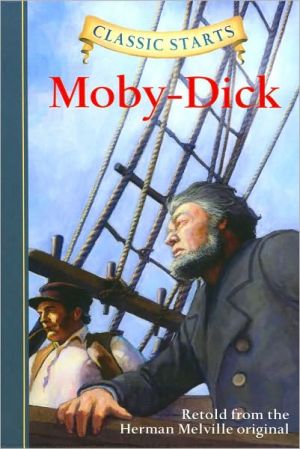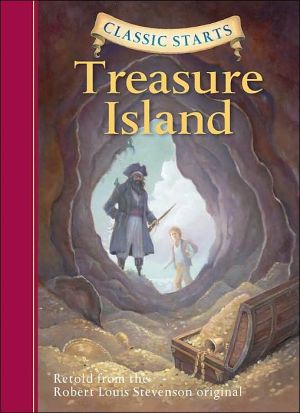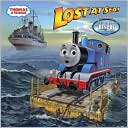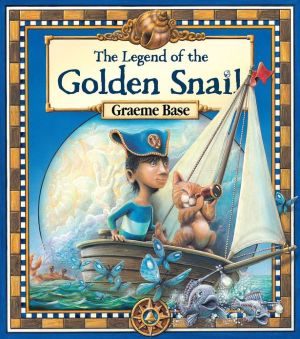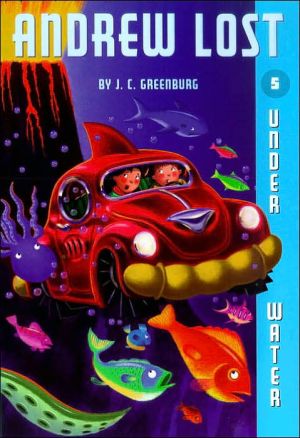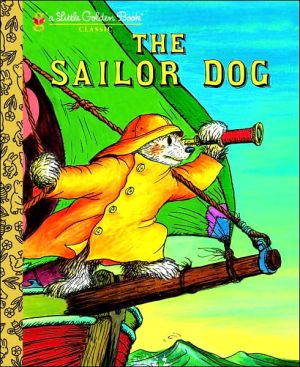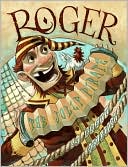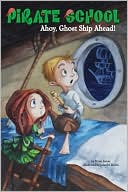Moby-Dick (Classic Starts Series)
Call me Ishmael. These three famous words begin one of America’s most epic novels, a tale of one obsessed captain, his doomed crew, and an elusive white whale named Moby-Dick. The massive original, however, can be very hard for young readers to navigate. This beautifully abridged and adventure-filled version will thrill children and whet their appetite for the complete work—when they are ready to tackle it.
Search in google:
One of the most widely-read and respected books in all American literature, Moby Dick is the saga of Captain Ahab and his unrelenting pursuit of Moby Dick, the great white whale who maimed him during their last encounter. A novel blending high-seas romantic adventure, symbolic allegory, and the conflicting ideals of heroic determination and undying hatred, Moby Dick is also revered for its historical accounts of the whaling industry of the 1800's.Children's LiteratureCan an abridged version of one of literature's great masterpieces do the original justice? Can such an attempt make a dense and sometimes rambling original more accessible to today's technology-inspired readers? The editor himself asks questions along these lines in his author's notes and it is this reviewer's humble opinion that he has quite successfully succeeded. Taking the best of Melville's original text, Needle injects historical references and invaluable observations on the life and times of the day to tell the story of Ahab, Ishmael, and the infamous whale. In doing so, Needle provides today's reader with a greater understanding of the shades of meaning inherent in Melville's lyrical original. A glossary and meticulously detailed drawing of a typical whaling ship provide the reader with even greater context. Raising the bar are Patrick Benson's amazing full-color illustrations and black-and-white sketches, managing quite magnificently to bring Melville's words and Needle's interjections to life. Somewhere between the pleasure (and pain) of the original and the ease of the movie lies this masterful abridged version.
Call me Ishmael. This resonant opening of Moby-Dick, the greatest novel in American literature, announces the narrator, Herman Melville, as he with a measure of slyness thought of himself. In the Scriptures Ishmael, a wild man sired by the overwhelming patriarch Abraham, was nevertheless the bastard son of a serving girl Hagar. The author himself was the offspring of two distinguished American families, the Melvilles of Boston and the Gansevoorts of Albany.\ \ Melville's father cast something of a blight on the family escutcheon by his tendency to bankruptcy which passed down to his son. Dollars damn me, the son was to say over and over. When he sat down in the green landscape of Pittsfield, Massachusetts, to compose Moby-Dick he was in debt, the father of one son, and another to be born a few days after the publication of the novel in England.\ \ Melville had published five novels previous to Moby-Dick; the first two did well, and then with the capriciousness of the public the subsequent novels failed to please. He was a known literary figure with a fading reputation. How he came upon the courage to undertake the challenging creation of the epical battle between a sea creature, a white whale called Moby Dick, and an old captain from Nantucket by the name of Ahab is one of literature's triumphant mysteries. Add to that, as one reads, that he was only thirty-two years old.\ \ Ten years before, in 1841, he had signed up as a common seaman on the whaling vessel Acushnet bound for the South Seas. Young Ishmael was drawn by the lure of the sea and by the wonder of the whale itself, the Leviathan, the monarch of the deep, "one grand hooded phantom,like a snow hill in the air." Until the discovery of petroleum oil in 1859 and Thomas Edison's invention of the incandescent lamp in 1879, whaling was a major commercial occupation in New England. Fortunes were made, grand houses were built, often with a "widow's walk" on the roof that testified to the great dangers of the enterprise. For the crew, service on a whaler was a drastic life of unremitting labor; foul, crowded quarters; bad food in scanty servings; contractual terms for years at miserable wages; brutalized companions picked up from all the ports of the world; tyrannical captains practicing a "sultanism" which Melville abhorred. A ship afloat is after all a prison. Melville was on three whalers in his four years at sea and from each, as we read in Typee and Omoo, the struggle is to escape, as he did when the boats anchored near exotic islands. He wrote about the misery of the whaling life, but not about whaling itself until he came to Moby-Dick. His imaginary whaler, the Pequod, death bound as it is, would be called, for an ordinary seaman, an agreeable berth. Ahab has no interest left beyond his internal struggle with one whale.\ \ Still, there is whaling, the presumption of it. When a whale is sighted small boats are detached from the main vessel and the men engage in a deadly battle to try to match, with flying harpoons, the whale's immense strength and desperation. If the great thing is captured, the deck of the main ship becomes an abattoir of blood and guts. The thick blubber is to be stripped, the huge head to be drained of its oils for soothing ambergris, for candles; the bones of the carcass make their way into corsets and umbrellas and scrimshaw trinkets. Moby-Dick is a history of cetology, an encylopedic telling of the qualities of the fin-back, the right whale, the hyena whale, the sperm whale, the killer whale, classified by size in mock academic form as folio, octavo, and so on.\ \ Information about a vanished world is one thing, but, above all else, this astonishing book is a human tragedy of almost supernatural suspensiveness, written in a rushing flow of imaginative language, poetical intensity, metaphor and adjective of consuming beauty. It begins on the cobbled streets of New Bedford, where Ishmael is to spend a few days before boarding the Pequod in Nantucket. The opening pages have a boyish charm as he is brought to share a bed with a fellow sailor, the harpooner Queequeg, an outrageously tattoed "primitive" who will be his companion throughout the narrative. Great ships under sail gave the old ports a rich heritage of myth, gossip, exaggeration, and rhetorical flights. Ishmael, on a Sunday, visits a whaleman's chapel to hear the incomparable sermon by Father Mapple on Jonah and the whale, a majestic interlude, one of many in this torrential outburst of fictional genius.\ \ As Ishmael and Queequeg proceed to Nantucket, the shadows of the plot begin to fall upon the pages. The recruits are interviewed by two retired sailors who will struggle to express the complicated nature of Captain Ahab. We learn that he has lost a leg, chewed off by a whale, and thus the fated voyage of the Pequod begins. Ahab has lost his leg to a white whale Moby Dick and is consumed with a passion for retribution. He will hunt the singular whale as a private destiny in the manner of ancient kings in a legendary world. However, Ahab is real and in command. The chief mate, Starbuck, understands the folly of the quest, the danger of it, and, as a thoughtful man longing to return to his wife and children, he will speak again and again the language of reason. "Vengeance on a dumb beast that simply smote thee from the blindest instinct! Madness! To be enraged with a dumb thing, Captain Ahab, seems blasphemous."\ \ The necessity of Starbuck's human distance from the implacable imperative of Ahab's quest illustrates the brilliant formation of this harrowing tale. But it is Ahab's story, his destiny, and, if on the one hand, he is a shabby, sea-worn sailor long mesmerized by mercurial oceans, he too has a wife at home and a child of his old age. We learn, as the story proceeds, that on a time ashore after his terrible wounding, he had fallen and by way of his whalebone leg been unmanned. He has suffered an incapacity not to be peacefully borne by one who in forty years had spent only three on land. Ahab knows the wild unsuitability of his nature, his remove from the common life.
IntroductionxviEtymologyxxviExtracts1Chapter 1Loomings17Chapter 2The Carpet-Bag22Chapter 3The Spouter-Inn26Chapter 4The Counterpane41Chapter 5Breakfast45Chapter 6The Street47Chapter 7The Chapel50Chapter 8The Pulpit53Chapter 9The Sermon56Chapter 10A Bosom Friend65Chapter 11Nightgown69Chapter 12Biographical71Chapter 13Wheelbarrow73Chapter 14Nantucket78Chapter 15Chowder80Chapter 16The Ship83Chapter 17The Ramadan97Chapter 18His Mark103Chapter 19The Prophet107Chapter 20All Astir111Chapter 21Going Aboard113Chapter 22Merry Christmas117Chapter 23The Lee Shore121Chapter 24The Advocate122Chapter 25Postscript127Chapter 26Knights and Squires128Chapter 27Knights and Squires131Chapter 28Ahab136Chapter 29Enter Ahab; to Him, Stubb139Chapter 30The Pipe142Chapter 31Queen Mab143Chapter 32Cetology146Chapter 33The Specksynder159Chapter 34The Cabin-Table162Chapter 35The Mast-Head168Chapter 36The Quarter-Deck, Ahab and All174Chapter 37Sunset182Chapter 38Dusk184Chapter 39First Night-Watch185Chapter 40Midnight, Forecastle186Chapter 41Moby-Dick193Chapter 42The Whiteness of the Whale203Chapter 43Hark!212Chapter 44The Chart213Chapter 45The Affidavit218Chapter 46Surmises227Chapter 47The Mat-Maker230Chapter 48The First Lowering233Chapter 49The Hyena243Chapter 50Ahab's Boat and Crew. Fedallah245Chapter 51The Spirit-Spout248Chapter 52The Albatross252Chapter 53The Gam254Chapter 54The Town-Ho's Story259Chapter 55Of the Monstrous Pictures of Whales279Chapter 56Of the Less Erroneous Pictures of Whales, etc.284Chapter 57Of Whales in Paint; in Teeth; etc.288Chapter 58Brit290Chapter 59Squid293Chapter 60The Line296Chapter 61Stubb Kills a Whale300Chapter 62The Dart305Chapter 63The Crotch306Chapter 64Stubb's Supper308Chapter 65The Whale As a Dish316Chapter 66The Shark Massacre318Chapter 67Cutting In320Chapter 68The Blanket322Chapter 69The Funeral325Chapter 70The Sphynx327Chapter 71The Jeroboam's Story329Chapter 72The Monkey-Rope335Chapter 73Stubb and Flask Kill a Right Whale, etc.340Chapter 74The Sperm Whale's Head-Contrasted View345Chapter 75The Right Whale's Head-Contrasted View350Chapter 76The Battering-Ram353Chapter 77The Great Heidelburgh Tun355Chapter 78Cistern and Buckets357Chapter 79The Praire361Chapter 80The Nut364Chapter 81The Pequod Meets the Virgin366Chapter 82The Honor and Glory of Whaling378Chapter 83Jonah Historically Regarded381Chapter 84Pitchpoling383Chapter 85The Fountain385Chapter 86The Tail391Chapter 87The Grand Armada395Chapter 88Schools and Schoolmasters408Chapter 89Fast-Fish and Loose-Fish411Chapter 90Heads or Tails415Chapter 91The Pequod Meets the Rose-Bud418Chapter 92Ambergris425Chapter 93The Castaway428Chapter 94A Squeeze of the Hand432Chapter 95The Cassock436Chapter 96The Try-Works437Chapter 97The Lamp442Chapter 98Stowing Down and Clearing Up443Chapter 99The Doubloon446Chapter 100The Pequod Meets the Samuel Enderby of London452Chapter 101The Decanter459Chapter 102A Bower in the Arsacides464Chapter 103Measurement of the Whale's Skeleton468Chapter 104The Fossil Whale471Chapter 105Does the Whale's Magnitude Diminish?475Chapter 106Ahab's Leg479Chapter 107The Carpenter482Chapter 108Ahab and the Carpenter485Chapter 109Ahab and Starbuck in the Cabin489Chapter 110Queequeg in His Coffin492Chapter 111The Pacific498Chapter 112The Blacksmith499Chapter 113The Forge502Chapter 114The Gilder505Chapter 115The Pequod Meets the Bachelor507Chapter 116The Dying Whale510Chapter 117The Whale Watch512Chapter 118The Quadrant513Chapter 119The Candles516Chapter 120The Deck523Chapter 121Midnight-The Forecastle Bulwarks524Chapter 122Midnight Aloft526Chapter 123The Musket526Chapter 124The Needle530Chapter 125The Log and Line533Chapter 126The Life-Buoy536Chapter 127The Deck540Chapter 128The Pequod Meets the Rachel542Chapter 129The Cabin546Chapter 130The Hat548Chapter 131The Pequod Meets the Delight552Chapter 132The Symphony554Chapter 133The Chase-First Day558Chapter 134The Chase-Second Day567Chapter 135The Chase-Third Day576Epilogue588Criticism and ContextHerman Melville: A Biographical Note590Letters597Moby-Dick and Its Contemporary Reviews607Moby-Dick and Its Modern Critics619from Herman Melville619"Seven Moby-Dicks"629"The Tragic Meaning of Moby-Dick"645"Ishmael"649from "Herman Melville's Moby-Dick"654"The Fire Symbolism in Moby-Dick"662Recommended Reading668
\ Children's Literature\ - Kris Sauer\ Can an abridged version of one of literature's great masterpieces do the original justice? Can such an attempt make a dense and sometimes rambling original more accessible to today's technology-inspired readers? The editor himself asks questions along these lines in his author's notes and it is this reviewer's humble opinion that he has quite successfully succeeded. Taking the best of Melville's original text, Needle injects historical references and invaluable observations on the life and times of the day to tell the story of Ahab, Ishmael, and the infamous whale. In doing so, Needle provides today's reader with a greater understanding of the shades of meaning inherent in Melville's lyrical original. A glossary and meticulously detailed drawing of a typical whaling ship provide the reader with even greater context. Raising the bar are Patrick Benson's amazing full-color illustrations and black-and-white sketches, managing quite magnificently to bring Melville's words and Needle's interjections to life. Somewhere between the pleasure (and pain) of the original and the ease of the movie lies this masterful abridged version.\ \ \ \ \ School Library JournalGr 3-6\ Rod Espinosa's creative graphic depiction (Magic Wagon, 2007) of Herman Melville's Moby Dick is a great way to introduce elementary age children to the classic as well as a terrific learning tool for middle school ESL students and exceptional children who struggle with reading. This interactive program allows students to read and listen to the book at their own pace. Narration can be turned on or off. When the text is read, dialogue panels are highlighted and enlarged. Sound effects and music enhance the text, and the graphics are excellent. Well organized with a table of contents, glossary, and brief multiple-choice quiz, this graphic novel ibook can be navigated easily by the youngest students.-Beverly S. Almond, Moore Square Museums Magnet Middle School, Raleigh, NC\ \ \ \ Stuart C. ShermanA great American addition with features more diverse than those in any previous editions of Melville's classic. \ —Stuart C. Sherman, Fine Print\ \ \ \ \ William EversonHistorically, the two great typographical edifices of West Coast printing are the grabhorn Leaves of Grass and the Nash Divine Comedy. Now the Arion Press Moby—Dick takes its place beside them…It is the textural West of hand composition that forms the chief glory of this work. Hoyem seems to have found the perfect measure to accommodate text to type. We turn page after page of matchless composition…as the magical result. I would venture the opinion that this constitutes a feat of craftsmanship unexcelled in modern printing. \ —William Everson, Fine Print\ \ \ \ \ Kirkus ReviewsFrom the team behind the adaptation of The Odyssey (1995), an audacious retelling that follows the main story line of Melville's monumental work—of Ishmael's tale of Captain Ahab's mad quest for revenge against the giant white whale that took his leg on a previous voyage. While rewrites for children of classic adult literature remain controversial, this one is stunning. The language, through which McCaughrean subtly brings out many of the metaphors of the original text, is unusually ornate for the format, making it—despite its storybook-look—more appropriate for readers beyond picture books. Although sometimes humorless, the lush prose rockets the story along like a square rigger under full sail, with all the beauty and complexity that entails. Ambrus's ample illustrations are full of character.\ McCaughrean largely succeeds in conveying to young readers the mood, language, story, and power of the original. For those disposed to retellings of the classics, this is a prime example of the way to do it.\ \ \ \ \ \ From Barnes & NobleA rich, complex, highly symbolic narrative that explores the deepest reaches of our moral and metaphysical dilemma through the extraordinary tale of Captain Ahab's insane quest for the great white whale. One of America's greatest novels.\ \
